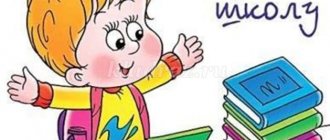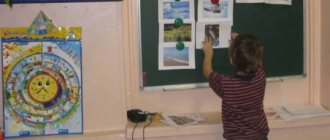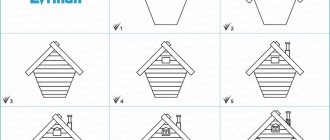Summary of educational activities for the development of self-service skills
Summary of educational activities for the development of self-service skills
Target:
Continue to teach children to independently care for their appearance and the condition of their clothing.
Tasks:
1. Strengthening children’s ability to put things back in their place
2. Formation of clothing care skills;
3. Formation of a desire for neatness; to the ability to notice and correct imperfections in appearance in oneself and other children;
4. Improving the ability to dress independently in the correct sequence;
5. Enrichment of vocabulary with the help of proverbs and sayings on the topic
Progress of the lesson
There's a knock on the door.
Educator:
Children, do you hear, someone came to visit us. Vika, let's go, open the door and meet the guest.
(An upset Luntik enters the group, introduces himself, begins to take off his outerwear and throws things around as he goes.)
Educator:
Hello! What happened, why are you so upset?
Luntik:
"Hello! My name is Luntik. My friends don't invite me to go out with them! So I'm upset. They say I'm sloppy, sloppy! Guys, tell me what these words are, what do they mean? I came to you for help, you know everything in kindergarten and can do everything!
Educator:
Luntik, we will help you! First, children, let's remember what these words mean - sloppy, sloppy?
(This is a person who does not keep his things orderly and clean and does not take care of his appearance.)
What did Luntik do wrong when he joined our group? (Scattered his things.) Let's tell you what you really need to do with them.
Children's individual answers:
- put the boots on the shoe rack,
- hang the jacket on a hook in the locker,
- Put the hat on the top shelf in the locker.
Educator:
And now Vanya and Polina will help me put Luntik’s things back in their places.
So that our advice is not forgotten, remember the proverbs and sayings about neatness that our children know.
Timur:
“The whole world is kept up by neatness”
Masha:
“Where there is neatness, there is neatness”
Seva:
“Whoever is neat is pleasant to people.”
Educator:
All things need to be looked after not only when they are old, but also when they are still new.
Luntik:
Oh, I still have a lot of things here! They're all mixed up and I don't know what to do with them! Teach me how to lay things out! (Pours things out of the bag.)
Several children help Luntik sort things into pairs, and neatly fold unpaired things or hang them on a chair.
Educator:
And our children also know that they need to not only carefully put things in their places, but also wear them carefully and take care of their appearance. Guys, let's look at our guest - what's wrong with his clothes?
(Children notice flaws in the doll’s clothes, and take turns going out to correct them)
- different socks,
- shoes on the wrong foot,
- shirt inside out.
Educator:
Remember one more lesson - “They are greeted by their clothes, but they are seen off by their minds” - this means that first of all people pay attention to the appearance of other people, their clothes, and only then to everything else.
Luntik:
Well done! Guys, you really know everything! You helped me a lot. But I want to see - do you know how to do all this yourself? I'll give you a test - who will dress correctly for a walk?
(The teacher selects 2 children who will show how they know how to dress. The test is carried out several times.)
Luntik:
Well done boys! Now I also know how to dress properly!
Educator
: So we helped Luntik! I hope now he won’t have any problems, and his friends will always invite him for a walk! Guys, let's remember what we taught our guest today? What proverbs and sayings does Luntik need to remember?
Luntik:
Thanks guys, you helped me a lot! I will remember your advice!
Open lesson with children of the middle group “Self-care skills”
Goal: Continue to teach children to independently care for their appearance and the condition of their clothing.
Tasks:
1. Strengthening children’s ability to put things back in their place
2. Formation of clothing care skills;
3. Formation of a desire for neatness; to the ability to notice and correct imperfections in appearance in oneself and other children;
4. Improving the ability to dress independently in the correct sequence;
5. Enrichment of vocabulary with the help of proverbs and sayings on the topic
Progress of the lesson
Educator: Children, this morning we received a letter, unsigned, no return address. Let’s read what is written there: “Hello! I need your help! I’ll come in the morning!”
Very interesting! (intercom ringing) And here, probably, is our guest!
(A doll enters the group, introduces itself, begins to take off its outerwear and scatters things as it goes.)
Doll: “Hello! My name is Katya doll. I'm upset. My girlfriends don't invite me to their place! They say I'm sloppy, sloppy! What kind of words are these, what do they mean? And what should I do now? You know everything here, so I decided to turn to you for help!
Educator: We know, Katya, how to help you! First of all, children, what do these words mean - sloppy, slob? (This is a person who does not take care of his things and his appearance.)
What did Katya do wrong when she entered? (She scattered her things.) Let's tell you what you really need to do with them.
Children's individual answers:
- put the boots under the bench,
- hang the jacket on a hanger,
- put the hat on the shelf.
the teacher helps put their outerwear back in its place. “So that our advice is not forgotten, remember the proverbs and sayings about neatness that our children know. Misha S. “Take care of the dress from new” (“means that all things need to be looked after not only when they are old, but also when they are still new”).
Doll: Oh, I still have a lot of things here! They're all mixed up and I don't know what to do with them! Teach me how to lay things out! (Pours things out of the bag.)
Children: Several children help the doll sort things into pairs, and neatly fold unpaired things or hang them on a chair.
Educator: “Things need to be put away, so you don’t have to look for them.” Children, you know that things need not only to be neatly put in their places, but also to be worn carefully and to take care of your appearance. Look at our guest - what's wrong with her outfit?
(Children notice flaws in the doll’s clothes, and take turns going out to correct them
- untied bow on the head,
- socks of different colors,
- slippers on the wrong foot,
- the blouse is not tucked in completely.)
Educator: Remember one more lesson - “They are greeted by their “clothes”, and seen off by their minds” (means that first of all people pay attention to the appearance of other people, to their “Clothes”, and only then to everything else).
Doll: Well done! Yes, you know a lot! You told me everything, and now I want to see - do you know how to do all this yourself? I'll give you a test - who will dress correctly for a walk?
(The teacher selects 2 children who will show how they know how to dress. And the rest come to the table, where cards with pictures of clothes are laid out, and show them in the correct sequence.)
Doll: Well done, guys! Now I also know how to dress properly!
Educator : So we helped the doll Katya! I hope she doesn't have any problems now! Let's remember what we taught our guest today? What proverbs and sayings does Katya need to remember?
Katya: Thank you guys, you helped me a lot! I will remember your advice!
Summary of self-care in the senior group
Summary of a lesson on developing self-service skills in the senior group “Every thing has its place”
Goal: To develop skills independently and with the help of adults and peers to maintain and restore order in the group.
Tasks:
Educational: instilling hard work, respect for working people: the ability and desire to appreciate one’s own and others’ work. Developing neatness, thrift, neatness, and the ability to take care of one’s appearance and one’s belongings.
Equipment: Household items and object pictures, a bear toy.
Preliminary work: The day before, the story “Masha the Confused” by L. Voronkova is read to the children and a conversation is held on its content:
-Who is the story about? Who woke up Masha in kindergarten?
-Why was Masha late for kindergarten one day?
-Why couldn’t she find her things right away? Where was the dress thrown? Who is to blame that Masha was late?
Progress
Educator:
-Guys, who keeps order in the house?
Children
: -Mother!
Educator:
- How do you help mom with this?
Children:
— We clean up our toys after we’ve played; We make our bed.
Educator:
— Who keeps order in the group? — Do you help adults with this? How?
Children:
We put the toys away, hang the clothes in the locker, put them on the high chair before going to bed, put the shoes on the shelf, set the table, and remove the dishes from the table after eating.
Educator:
- What great fellows you are!
-We’ll now go on a tour of the group and see if all the things are in place. If someone does not put the toy back in its place, then the toys may become offended and hide from you.
Educator:
(children and teacher approach the sports corner). Guys, please tell me what is missing in our sports corner?
Children:
Jump rope and ball.
Educator:
He approaches the music corner with the children and asks them to name what is missing?
Children:
A tambourine harmonica and a basket of rattles are missing.
Educator: Children, look how many toys they hid from us. But I think I know who can help us find the toys.
Look who's coming to us!
Children:
It's a bear!
Educator:
Children, let's ask the bear to help us find the toys.
Children:
Let's! (they start looking for toys together with the bear)
Bear: Phew, guys, we found all the toys and put them back in their place. Well done we did it. I'm tired, let's relax and play a game! Do you agree?
Children:
Yes, we agree!
Bear: the game is called “Every thing has its place” (Didactic game). Have you ever played such a game?
Children:
No
Bear: Then let's play now.
On the table there are a lot of small items (pencils, ribbons, hairpins, elastic bands, decorations for dolls, cubes, some parts from the designer) and boxes, boxes, baskets, cups.
The teacher and Mishka ask one of the called children to find a place for each item. After the game, Mishka rewards the children with stars for their help.
Educator:
Why should every thing be in its place?
Educator:
Why should every thing be in its place?
Children:
So as not to waste time searching, you could take it right away.
Educator:
Who should keep order?
Children:
Adults and children.
Educator:
Guys, you are all great guys, but without Mishka’s help we couldn’t cope with you! Is it true?
Children:
Yes.
Educator:
Let's thank Mishka for his help then.
Bear:
I was glad to help you! See you soon guys!
Summary of educational activities for self-care in the first junior group of preschool educational institutions
Synopsis of educational activities on self-care in the first junior group.
Topic: “Let's teach Antoshka to wash himself” Goal : Formation of self-care skills Objectives: 1. To form children’s value attitude towards maintaining cultural hygienic skills;
2. To consolidate children’s knowledge of the names and purposes of personal hygiene items. 3. Improve skills in using these items. 4. Activate speech, replenish vocabulary. 5. Consolidate children’s knowledge about the sequence of actions when washing, using an algorithm and artistic expression. 6. Develop fine motor skills and sensory perception. 7. Cultivate the desire to be clean, neat and beautiful. Progress of the lesson:
Educator: In the morning the kids got up and came to their kindergarten. We are glad to see you as always, We have had guests here since the morning, Say hello, friends! Children greet those present. Educator : Now sit quietly on the chairs. I have prepared a wonderful poem for you that says that everyone washes their face in the morning. The teacher shows the children a picture of animals washing themselves.
Early in the morning, at dawn, little mice, and kittens, and ducklings, and bugs and spiders wash themselves.
Only you didn’t wash your face, and you were left dirty, and your stockings and shoes ran away from being dirty. Shows a picture of a dirty boy. Educator : Guys, look at this boy, his name is Antoshka, he alone did not wash himself and remained dirty. Do you know, why? Children : No. Educator : Then let's call him to us and ask. The teacher brings out the boy's doll Antoshka with dirty palms. The teacher turns to Antoshka Teacher : Antoshka, tell me, why are you so dirty? You probably don't know how to wash your face? Antoshka : No, I don’t know how to wash myself. Educator: Guys, do you know how to wash your face? Children's answers. Educator : Let's teach Antoshka how to wash himself too. Let's look at pictures of how to wash your hands correctly. The teacher and children look at the washing sequence diagram. Educator: Antoshka, did you remember the procedure for washing? Antoshka: Not really. Educator : I have a basket with washing items in it. Now I will show them to you. And you tell me what needs to be done with them. Questions for children : What is this? Children : Soap. Educator : What is it for? Children : Lather your hands. Educator : Let's show how to wash your hands with soap. The teacher and the children imitate washing their hands with soap. Educator : Now we’ll show you how to wash your hands with soap. Children show. Educator: What kind of object is this? Children : Towel Teacher: Why is it needed? Children: Wipe your hands. Educator : We'll show you how to dry your hands with a towel. They imitate wiping their hands with a towel. Educator: Here, Antosha, what objects help us to be clean, and now we will teach you how to use them. Educator : Guys, where do we always wash ourselves? Children : In the washroom. Educator : Let's go with Antoshka to the washroom and show him how to wash himself. The teacher with the children and Antoshka go to the washroom. The diagram is attached above the washbasins. Educator : Guys, before you start washing your hands, what should you do? Children: Roll up your sleeves. Educator : Tanya, show me how to do this. The child shows how to roll up the sleeves. Educator : Guys, let's roll up all our sleeves. And he does the same to the doll. Educator: What do we do next? Children : Let's open the water. The teacher and the children open the tap. Educator : We opened the tap, what do we do next? Children : First, we wet our hands with water. The teacher, Antoshka and the children wet their hands with water. Educator : What do we do next? If the children find it difficult to answer, the teacher prompts the children. Children : Take soap and lather your palms. The teacher soaps Antoshka's hands, the children repeat the soaping process. Educator: Let's rub one palm against the other. He rubs Antoshka's palms. Children do the same. Educator : Now we wash off our soapy palms with water. Everyone washes the soap off their hands. Educator : So we washed ourselves. What, Timofey, needs to be done now? Child : Shake water off your palms over the sink. The children do it. The teacher shakes the water off the doll's hands. Educator: Correct, then turn off the water in the tap. Children turn off the tap. Educator : Dry your hands with a towel, lower your sleeves. The children show how it should be done. The teacher wipes the doll’s hands and lowers his sleeves. Educator : Now you, Antosha, are clean and can safely go to your home. Just promise our guys that you will wash your face every day. Antoshka : I now know how to wash my face properly and I promise to do it every day. Educator : And we guys with clean hands can now safely play with toys. Let's go to the game room. Antoshka says goodbye to the children and leaves.
We recommend watching:
Scenario of spring entertainment for children of the younger group Integrated lesson with children of the first group of early age Synopsis of educational activities in the 1st junior group to familiarize themselves with the world around them. Visiting a fairy tale Technological map for organizing joint activities with children of the 2nd early group
Similar articles:
Lesson notes for the 1st junior group of kindergarten. Introduction to clay
Lesson summary for an early age group. Getting to know the sun
Summary of a game development lesson in kindergarten in the second group of early age on the topic: Animals
Summary of a game lesson for children of the third year of life on the topic: Octopus
Summary of a game lesson for children of the third year of life on the topic: Clocks





